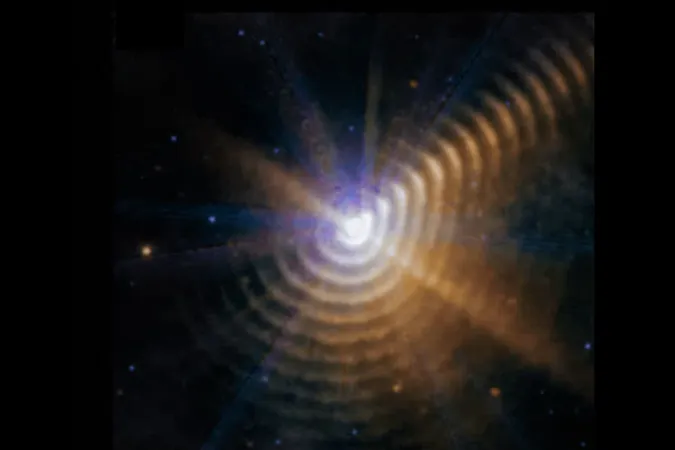
Stunning Webb Telescope Image Reveals Dying 'Shelled' Star System in Detail
2025-01-14
Author: Siti
Introduction
The James Webb Space Telescope has unveiled a breathtaking and precisely detailed image of Wolf-Rayet 140, a fascinating binary star system located approximately 5,000 light-years from Earth. This stellar duo is encircled by shimmering concentric dust rings, which intriguingly resemble the cross-section of a tree when viewed from afar.
Findings and Insights
The recent findings from Webb not only confirm the existence of these dust rings but also provide essential insights into how critical elements, like carbon, are spread throughout the universe. The analysis of these stunning images was published in The Astrophysical Journal Letters earlier this month and presented at the 245th meeting of the American Astronomical Society in National Harbor, Maryland.
Webb Telescope's Role
Emma Lieb, the lead author of the study from the University of Denver, emphasized the monumental role of the Webb Space Telescope, stating, 'The telescope not only confirmed that these dust shells are real, its data also showed that the dust shells are moving outward at consistent velocities, revealing visible changes over incredibly short periods of time.'
Wolf-Rayet Stars
Wolf-Rayet stars are known to be on the brink of becoming supernovae. Typically larger than the Sun, these stars experience rapid mass loss as they approach the end of their lifespan. When they ultimately meet their doom, they eject their materials into space with an explosive brilliance. In the WR 140 system, only one of the stars is classified as a Wolf-Rayet star, boasting a mass roughly ten times that of our Sun.
Past Observations
Webb previously captured imagery of other Wolf-Rayet stars, including WR 124, which is around 30 times the mass of the Sun and located approximately 15,000 light-years from our planet. WR 124's dramatic streams of gas and dust are observed to be racing away at speeds exceeding 93,200 miles per hour (150,000 km/h).
Dust Shells
Over the past 130 years, WR 140 has expelled more than 17 dust shells into the cosmos. The oldest of these shells have dissipated to an undetectable extent. Remarkably, the dust shells surrounding WR 140 are moving at extraordinary speeds, expanding at over 1,600 miles per second (2,600 km/s), outpacing those from WR 124.
Visual Representation
In a captivating visual representation, the animation illustrates how these dust shells originate from the dynamic interactions between the binary stars, where their stellar winds collide, compressing material into carbon-rich dust that is cast into the universe. Each distinct ring seen in the images corresponds to one of the stars' eight-year orbital cycles, further reinforcing the tree ring analogy.
Comparative Observations
In a comparison of mid-infrared images captured in July 2022 and September 2023, the significant expansion of the dust shells is evident. As co-author Ryan Lau, an astronomer at NSF’s NOIRLab, noted, 'Mid-infrared observations are absolutely crucial for this analysis, since the dust in this system is fairly cool.'
Future of WR 140's Wolf-Rayet Star
The fate of the Wolf-Rayet star in WR 140 remains uncertain. It could meet its end in a dramatic supernova explosion or potentially collapse into a black hole. If it transitions into a black hole, the surrounding dust shells would likely remain intact, whereas a supernova would violently disperse the material.
Conclusion
Regardless of how and when this dying star will end its life, the Webb Space Telescope continues to be an invaluable tool in unraveling the mysteries of the universe and understanding the lifecycle of stars, as well as their role in distributing vital elements, such as carbon, across the cosmos. Stay tuned for more celestial discoveries unfolding in the vast universe above!





 Brasil (PT)
Brasil (PT)
 Canada (EN)
Canada (EN)
 Chile (ES)
Chile (ES)
 Česko (CS)
Česko (CS)
 대한민국 (KO)
대한민국 (KO)
 España (ES)
España (ES)
 France (FR)
France (FR)
 Hong Kong (EN)
Hong Kong (EN)
 Italia (IT)
Italia (IT)
 日本 (JA)
日本 (JA)
 Magyarország (HU)
Magyarország (HU)
 Norge (NO)
Norge (NO)
 Polska (PL)
Polska (PL)
 Schweiz (DE)
Schweiz (DE)
 Singapore (EN)
Singapore (EN)
 Sverige (SV)
Sverige (SV)
 Suomi (FI)
Suomi (FI)
 Türkiye (TR)
Türkiye (TR)
 الإمارات العربية المتحدة (AR)
الإمارات العربية المتحدة (AR)